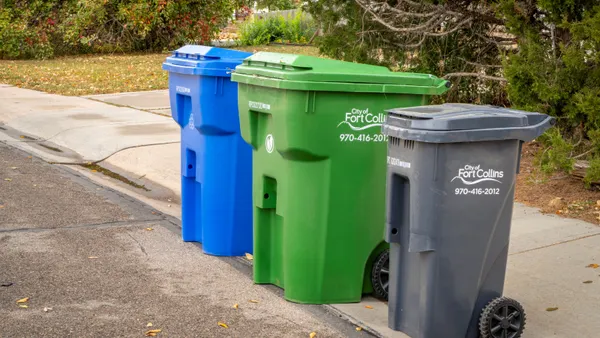Dive Brief:
- According to a new life cycle assessment released by the Corrugated Packaging Alliance (CPA), the corrugated industry's emissions dropped by 35% between 2006 and 2014. The peer-reviewed assessment was conducted by the CPA and National Council for Air and Stream Improvement.
- The assessment looked at the environmental effects from 1 kilogram of industry-average corrugated material manufactured in 2014 across a range of indicators. Greenhouse gas emissions, eutrophication, acidification, smog, ozone depletion, respiratory effects, fossil fuel depletion, water use, water consumption, renewable energy demand and non-renewable energy demand were all considered.
- The overall reduction was mainly influenced by the use of non-fossil fuel energy sources in the production process and higher material recovery rates. According to the CPA, recovery rates for old corrugated containers increased from 72% in 2006 to 89.5% in 2014.
Dive Insight:
As shown by previous reports from the American Forest & Paper Association, recovery rates for paper and corrugated products have continued to rise in recent years. While changing consumer trends have led to concern about the future of many paper products there have been fewer worries about corrugated. The longstanding existence of a separate initiative specifically dedicated to corrugated — jointly sponsored by the American Forest & Paper Association, the Independent Packaging Association, the Fibre Box Association and TAPPI - shows just how important the material is to the paper industry.
The material's value in the eyes of recyclers, and manufacturers such as Pratt Industries, is a sign of continued strength despite a dip in value on the market earlier this year. While opinions vary on how much e-commerce is affecting overall volumes and recovery rates it's clear that the trend is at least good for business in the corrugated manufacturing industry. Despite some lingering questions about sustainable packaging, particularly in meal kits, e-commerce purchases are only projected to grow in the coming years.
Maintaining such a high recovery rate will be a top priority for the corrugated industry as more of this volume potentially shifts from stores to consumers. The subject appears to be a particular point of pride for CPA, as the group issued a press release earlier this year responding to claims of recovery rate manipulation by the plastic container company IFCO.









